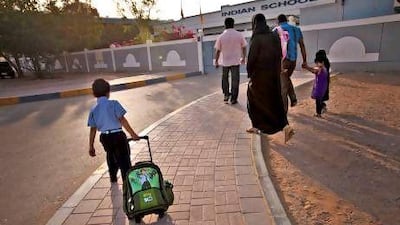Al AIN //When parents dropped off their children for the start of the new term yesterday morning, they found the city's 'school road' unusually quiet.
There are 33 campuses on Khalid Bin Sultan Street, meaning the morning school run is concentrated in one place at one time for more than 32,000 students.
The resulting traffic chaos has earned the street the nickname of 'headache road'.
But yesterday, 19 of the 33 schools were experimenting with staggered school timings. Eight schools began at 7.30am, nine at 8am and two at 8.15am.
"This is a good day," said Khaled Abdulla Al Shamisi, one of four police officers assigned to monitor the scene. "This is a very good system because there is no traffic. The headache road is all clear.
"Before, all the roads around this roundabout leading to the schools would be very difficult to manage and it would start by 7am.
"There were accidents all the time. Now we hope this will not happen."
The system was drawn up by the municipality, Department of Transport and Abu Dhabi Education Council (Adec) after complaints about traffic jams during pick-up and drop-off times.
The crowded streets near schools and resulting pollution have also been hazardous for children.
"Adec communicated its recommendations and findings regarding the pilot project to school principals, who in turn made sure that parents were well informed about the advantages of committing to the new school hours," said a spokesman for the Private Schools and Quality Assurance Sector at Adec. "We expect less traffic congestion, which will lead to parents dropping off children at school on time."
Dr Michal Grivna, the associate professor in the Department of Community Medicine at UAE University, said a staggered timing system was one of the recommendations he made after conducting a study on the safety of pupils across 182 Al Ain schools in 2005.
"The study was prompted by two serious cases that occurred where young children were involved," said Dr Grivna. "The parking zone outside the schools is not properly designed. There is not enough space for a child to embark and disembark from the car."
Dr Grivna said the proximity of schools to the main road was also an issue of concern.
"Cars stop everywhere and children run between them," he said. "With most parents driving 4x4s, it is hard to see them."
Mohammed Al Mansori, the owner of Al Sanawbar School, said the start of term had never been so peaceful.
"It had been so troublesome in the past and there would be cars lined right till the end of the road," said Mr Al Mansori, whose daughter attends the school. "Sometimes it has been so full that I would have to park my car a block away and walk her to school."
Mohammed Shaidul, whose five-year-old brother attends the Indian School, found the area better managed but remained sceptical about the system.
"I do not know if this is because school timings have changed or because some schools have not opened yet," said Mr Shaidul. "There should be a longer delay between the opening hours of schools - at least an hour for each set of schools to make a difference."
Mohammed Noor, a bus driver for Darul Huda Islamic School, was surprised by the lack of cars.
"What has happened?" asked the driver, who picks up 30 children by 6am every day. "I got to school 15 minutes before normal time. If it goes on this way, I can pick them up a little later."
Mr Noor said traffic signals at the junction would help solve traffic congestion. "They can help maintain some order," he added.
The municipality said it was working on signals and other projects to reduce school-run traffic, including pedestrian crossings, designated drop-off locations for pupils and a bus lane.

